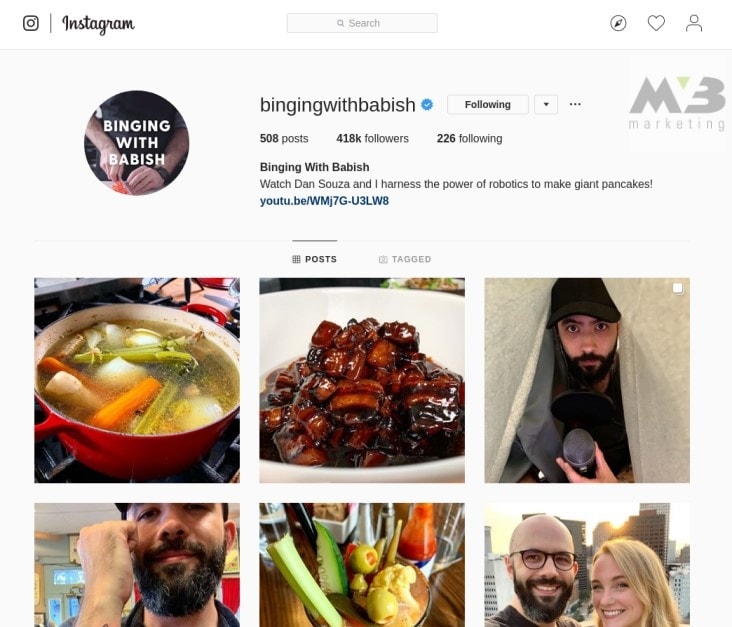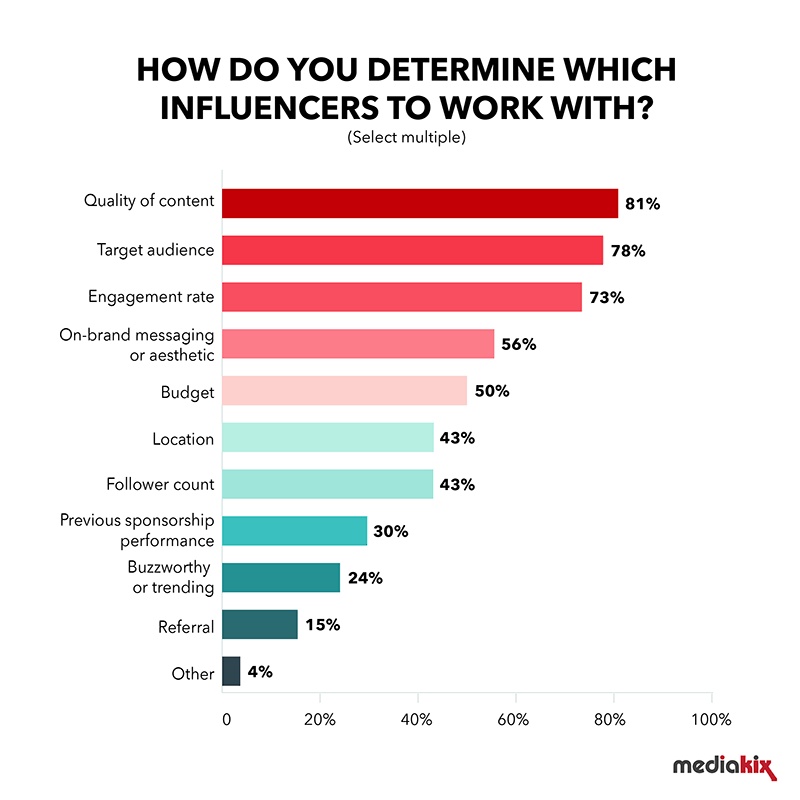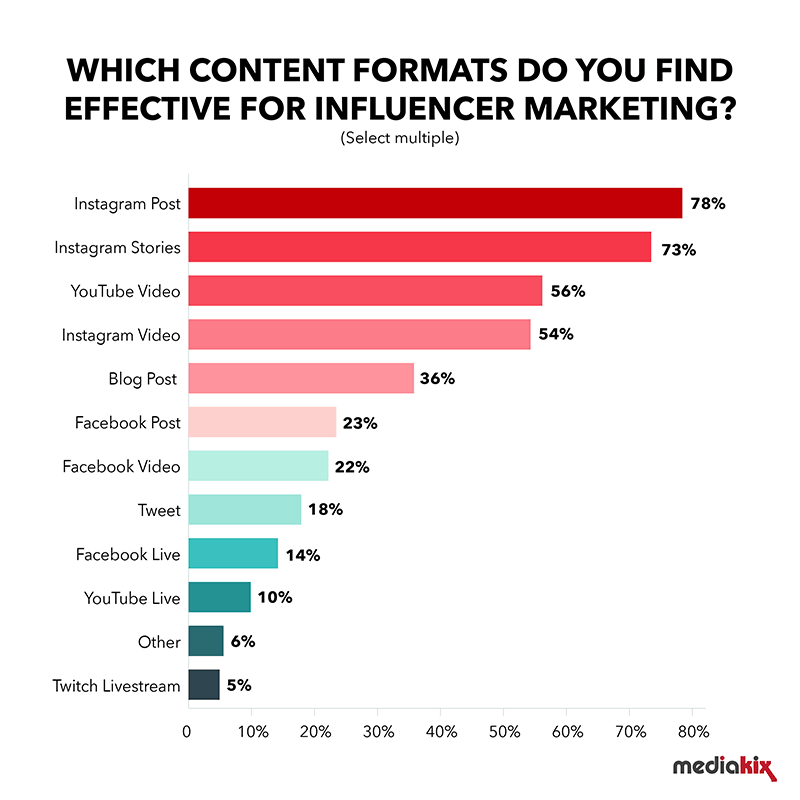TUTORIAL: Discover New Audiences with Influencer Marketing
Influencer marketing is on the rise—and it’s everywhere. On Instagram, YouTube, and even in your local restaurants and retail stores, you can spot influencers in their natural habitats. Even so, it’s not always easy to create your own influencer campaign.
Do you know how to reach out and create content with people operating outside your industry?
If not, don’t worry. We’re here to teach you.
Your competition is already boosting their influencer budgets. If you aren’t using influencers in your next campaign, you need to.
But what does that process look like? How can you measure the success of your relationship with an influencer?
Step 1: Set Goals (and be as ambitious as you want!)
Influencers operate on just about every social media platform. Just take a closer look next time you’re scrolling the ‘gram, and chances are, you’ll find a sponsored post.
Instagram isn’t the only platform you can use—but it is by far the leading platform for influencers, followed by Youtube, Facebook, and good old blogs.
You’ll need to decide early on which platform you want to focus on, and, subsequently, what you want to achieve by using that platform.
Consider your goals. Do you want to:
- Sell your products
- Make a large announcement
- Tell a brand story
- Follow up on industry developments
- Educate your consumers
You can start small, with just one of these goals in mind—but all of these can be achieved through an influencer strategy.
The most common budget for influencer marketing is $1,000 – $10,000/year, followed by $100,000 – $500,000/year. Don’t forget to keep your budget in mind.
Step 2: Identify Your Audience (and theirs)
Once you’ve set that goal, you can focus on your audience. Different types of influencers attract different consumers. Who are you marketing to?
Break your desired audience down into the following categories before deciding which influencers you want to collaborate with.
- Age: The divide between millennials, baby boomers, and their trust of advertising has never been greater; where millennial audiences tend to trust influencers, boomers respond better to well-established celebrities.
- Location: You can take advantage of locality and local SEO in your advertisements if you know where you want your audience to be based.
- Gender: Traditional gender divisions dominate a number of industries, breaking down everything from razor blades to pens.
- Income Level: Those without significant disposable income won’t necessarily be able to afford – or may not even want – the same kind of products that someone with significant disposable income does.
- Education Level: How specialized is your product, and will your target audience need specific qualifications to use it?
- Family Status: Toy manufacturers want to target mothers as well as their children, so why not segment for married couples.
- Occupation: Some consumers are looking for tools they can use on the job. As such, your audience segmentation should consider the different ways your product could be used in the workplace.

Step 3: The Fun Part. Choose Your Influencer!
There are different types of influencers on social media. You’ll want to choose your influencer’s reach based on follower account and “influencer status,” as elaborated on below:
- Mega-influencers: Mega-influencers have over a million followers on at least one of the Big Four social media platforms. Examples include Andrew Rea’s “Binging with Babish” or the ever-popular Selena Gomez.
- Macro-influencers: Macro-influencers have up to a million followers on one of the Big Four social media platforms, but no more.
- Micro-influencers: Micro-influencers cost less to hire on than more popular influencers do, and their reach can help you target a niche audience. For example, consider Jesse Driftwood’s successful partnership with Audible.
- Local influencers: These include friends, family members, and your typical, social media-using consumer. You can outsource user-generated content or hire someone with 1,000 followers or less to rep your product in a niche market, generating consumer trust as a result.

As mentioned, you’ll find influencers on just about every social media platform. No matter what level they operate on, you should be able to use the following criteria to discover relevant influencers for your brand:
- Quality of content
- Audience
- Engagement Rate
- On-Brand Content
- Budget

With this information at hand, you’ll be able to generate an outreach list.
Step 4: Don’t Be Nervous to Reach Out
With the aforementioned list in hand, you’ll be ready to start reaching out to potential influencer partners. You can do this one of two ways.
Option One: Slide Into Their DMs
Anyone can cold email or direct-message an influencer. Pro: it’s easy. Con: anyone can do this.
While this strategy can work, and may be a good option if you’re reaching out to a large pool of influencers, it doesn’t guarantee that you’ll receive any response—especially if you’re trying to work with high-profile individuals.
If you’re not a well-known brand yourself, you may want to try…
Option Two: The Research Angle
Think of influencer marketing like a business proposal—or even a personal relationship. Start by familiarizing yourself with the influencer’s particular brand:
- Subscribe to his or her blog or social media channels to learn more about the individual’s long-term content posting schedule.
- Read introductory emails/about pages.
- Get to know their target audience, and make sure it matches yours. (Otherwise, your targets may not know the influencer, and that defeats the purpose.)
- If you want to go a step further, respond to his or her audience questions and otherwise engage with the influencer’s work. (Not necessary for large, established brands, but a good tactic for smaller businesses.)
Once you’ve done your research and/or preliminary contact, it’s time to reach out.
Make sure you find the right contact information. Many influencers have a media kit or management email where they accept partnership requests.
This first contact is essential for your success. In your email, don’t forget to:
- Provide Details About Your Potential Partnership: What would the influencer be expected to do, how long would the partnership last, and what would the rewards be?
- Create Deadlines: Influencers are busy people. Give them a date by which they should ideally commit or submit a sample of their work. When you do, you’ll be professionalizing your contact and ensuring that, if they’re not interested, you can move on without feeling as though you’ve missed an opportunity.
Step 5: Collaborate to Create Content
Once an influencer commits to working with your business, it’s time to start brainstorming content. There are a number of different ways you can work with an influencer, including the following:
- Share Free Samples: When you offer free samples of your product to an influencer, you provide the opportunity to create an unboxing video or to simply spread the word about your product to his or her audience.
- Ask for Product Reviews: More specifically, you can utilize free samples to cultivate product reviews. These reviews can not only be posted on your site, but they can also appear on YouTube, Instagram, and individual influencer blogs.
- Promote Giveaways: You can also provide influencers with a fair number of your products. They can, in turn, host a giveaway of your products through their platforms. This strategy pulls double-duty: it broadens your influencers’ audiences, boosting their engagement, and it drives more consumers toward your platform.
- Pay for Sponsored Posts: Sponsorships have been part of the marketing industry for as long as it’s been in operation. You can sponsor an influencer’s work and receive an ad spot in return. It seems simple, but doing so for a niche influencer will help spread the word about your product within that attentive community.
- Cultivate Guest Posts: Similarly, you can invite an influencer to create guest content for your platform. This can take the form of a text post, video, infographic, or other media presentation. Having an outsider perspective on your industry is a breath of fresh air for your audience, and it brings an extra dose of creativity to any ad campaign you may be running.

Step 6: Don’t Forget to Nurture Your Relationships
You’ve established your relationship and created content with a specific influencer. And now? Time to cultivate that relationship.
After all, influencer marketing relies upon the influencer. The new consumers this partnership brings to your business will depend entirely upon that influencer. If you want to retain them, you’ll need to retain a positive relationship.
The best way to nurture your relationships with influencers is to understand what they want out of your partnership. While these goals will vary by person, the most common ones – according to a survey conducted by Augure – include:
- Increased audience growth
- Increase content quality
- Image cultivation
- Perks
- Money
- New experiences
While your influencer holds a unique position in the job market, he or she is still a peer. Communicate regularly to ensure that you’re meeting each other’s needs. If you intend to partner with an influencer over the long haul, then keep some of the aforementioned ambitions in mind.
Step 7: The Proof is in the ROI
The final test: is influencer marketing working for you? Don’t forget to analyze the data to help ensure that an influencer relationship is providing a positive ROI for your business.
Nearly 90 percent of businesses find that ROI from their influencer marketing campaigns is comparable or better than other marketing strategies.
When working with influencers, it can be difficult to utilize the Big Four’s existing social media analytic tools. Unless you’re allowing influencers to post directly from your business’ account, you’ll have to rely upon analytic reports or reflections in your own sales to determine your partnership’s ROI.
Alternatively, you can collect data regarding the following areas to assess the success of your partnership:
- Direct Sales: Since your partnership began, have your direct sales been on the rise? You can measure this specifically by providing your influencer with an individualized audience discount code and then assessing the number of times that code is used on your platform.
- Conversions: Conversions as measured through influencer partnerships include likes, retweets, and other forms of engagement and sharing of content on social media. Have your influencer post a piece of content and see for yourself how much engagement that work generates. If the conversions outweigh the cost/time of content creation, then you’re in the social black.
- Social Media Following: If you’re looking to spread the word about your brand, you’ll want to follow your follower account after partnering with an influencer. A sharp spike in the number of people following you is an obvious sign of partnership success. However, you’ll want to keep an eye out for long-term, substantial commitment as opposed to an immediate jump. Likewise, you should assess audience retention when partnering with an influencer to ensure that his or her audience’s commitment isn’t temporary.
Need further guidance? Reach out to our experts at MV3.
If you’re looking to integrate influencers into your next marketing campaign but this all sounds like a little much, the team at MV3 can help.
Our professional team simplifies the influencer marketing process. We match you with strategies that help you meet your goals. Whether you need help crafting a cold-open email or designing a marketing strategy for influencers you already have on staff, we’ll keep you on the track to success.
Conclusion
Is your company in need of help? MV3
Marketing Agency has numerous Marketing experts ready to
assist you. Contact MV3 Marketing to
jump-start your business.


